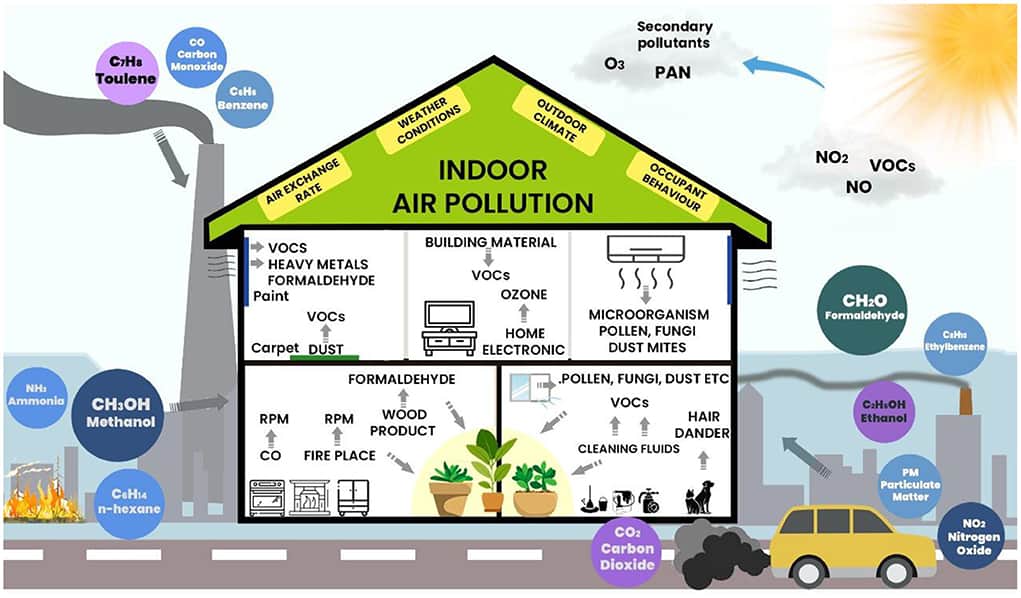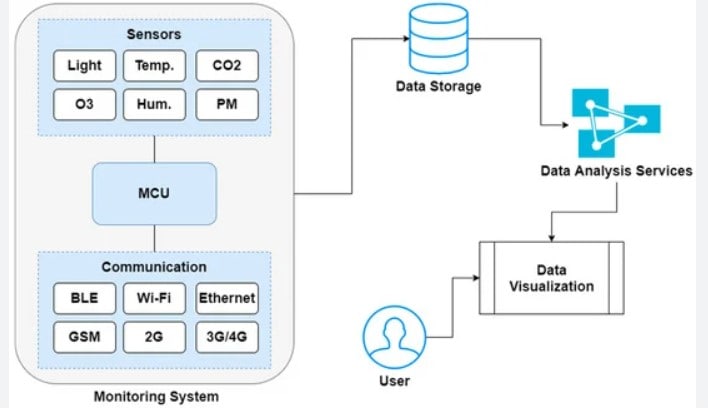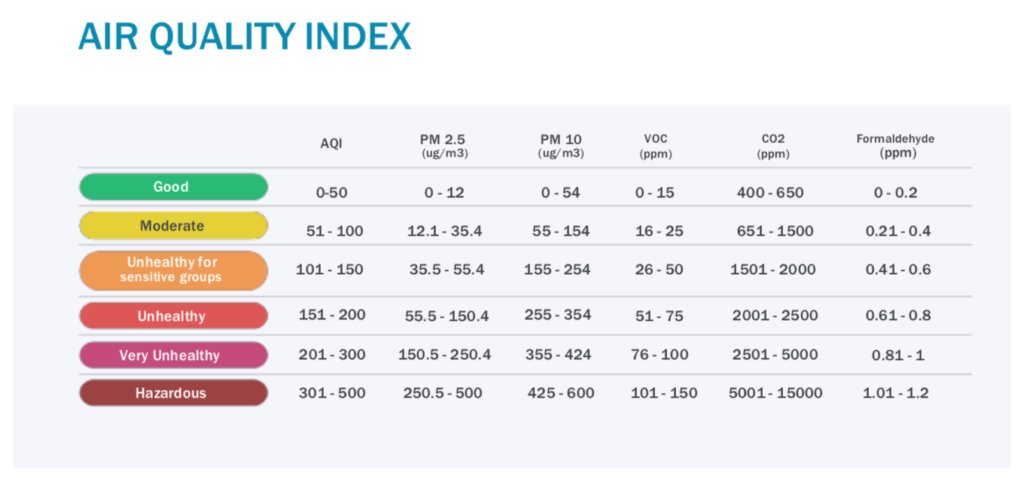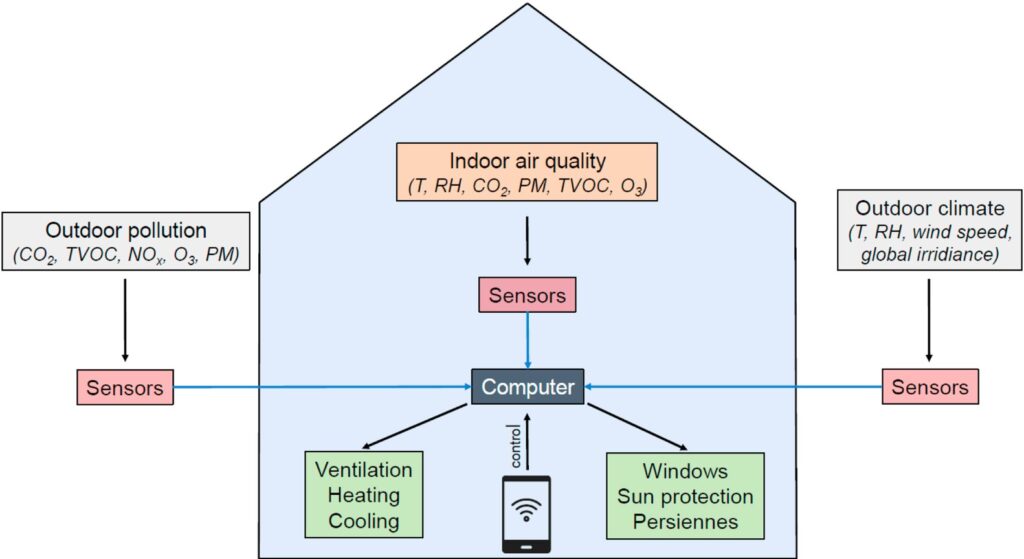In our daily lives, we often prioritize factors such as clean water, nutritious food, and regular exercise to ensure our well-being. However, one crucial aspect that often goes unnoticed is the quality of the air we breathe, especially indoors.
During my research for this article, I came across a report from the EPA that surprised me. It revealed that, on average, Americans spend around 80–90% of their time indoors, where certain pollutants can spike to 2–5 times higher levels than outdoor air. Shocking right?
that surprised me. It revealed that, on average, Americans spend around 80–90% of their time indoors, where certain pollutants can spike to 2–5 times higher levels than outdoor air. Shocking right?
A few days ago, one of my friends suggested that I buy an indoor air quality monitor to assess the air quality in my home. I was surprised by the results, and I’d like to share them in this article.
However, I want to make it clear that this article is not a sales pitch for IAQ monitors, nor do I intend it to be. My goal is to provide factual information and help you understand the gravity of rising indoor air pollution and its effects on our health.
I’ll also go over the capabilities of these smart indoor air quality monitors and their various applications. If you found this article helpful, please share it with your friends and family.

What is an indoor air quality monitor?
An indoor air quality monitor is a device that measures temperature, humidity, particulate matter, volatile organic compounds, carbon dioxide, and other pollutants in indoor air. It displays real-time data on a digital screen or in an application to help keep the indoor environment healthier.
I know, that pretty much sounded like a definition 🙂 In simple terms, an indoor air quality monitor (IAQ monitor) is a device or gadget equipped with advanced sensors that track and record the different air pollutants in your home, school, or office.
These indoor air quality monitors are also known as “Air Sensors”. To be honest, I’m not sure why, but it doesn’t seem appealing enough to purchase a product called “Air Sensor” on Amazon unless you’re a gadget enthusiast like me.
As mentioned earlier, AIQ monitors generally come with a ton of advanced sensors that can detect and measure various pollutants indoors.
For instance, PM sensors measure the concentration of airborne particles , ranging from fine particles (PM2.5) to larger particles (PM10), which can originate from sources such as combustion processes, dust, and pollen.
, ranging from fine particles (PM2.5) to larger particles (PM10), which can originate from sources such as combustion processes, dust, and pollen.
VOC sensors detect the presence of volatile organic compounds emitted by various household products, building materials, and indoor activities, which can have adverse health effects when present in high concentrations.
emitted by various household products, building materials, and indoor activities, which can have adverse health effects when present in high concentrations.
CO2 sensors monitor carbon dioxide levels, providing insights into indoor ventilation and occupancy patterns, as elevated CO2 levels may indicate inadequate ventilation or overcrowded spaces.
Whatever the data collected by IAQ monitors, it is typically displayed in real-time on a digital screen or transmitted to a smartphone app or online platform for remote monitoring and analysis.
For example, the IAQ monitor I use comes with a super handy app. It gives me all the information about the different pollutants hanging out in my home, and it shows me how they change throughout the day in easy-to-read graphs.
In addition, I can check out past data too! It’s cool because I can see how things have progressed throughout the day, week, or even month. It’s like an experiment—you can even try placing the monitor in different spots at different times to see what happens!


Some IAQ monitors go all out with extra features like data logging, trend analysis, and even connecting with your smart home system to control ventilation or air purifiers automatically. It’s pretty cool stuff, but a bit expensive.
The University of Surrey in the UK did a study where they integrated different smart home gadgets with IAQ monitors to see how environmental factors and people’s habits influence indoor air quality. You can look into it if you’re interested.
it if you’re interested.

According to a survey by the UN Environment Programme , indoor air pollution is recognized as a major global issue. It’s particularly concerning in developing nations, where vulnerable groups like women, children, and the elderly are hit the hardest by its effects.
, indoor air pollution is recognized as a major global issue. It’s particularly concerning in developing nations, where vulnerable groups like women, children, and the elderly are hit the hardest by its effects.
Furthermore, research from the EPA has shown that indoor air can contain higher levels of pollutants than outdoor air, particularly in poorly ventilated or tightly sealed buildings.
Indoor air pollution has been linked to respiratory illnesses, cardiovascular problems, cognitive impairment, and other adverse health risks.
has been linked to respiratory illnesses, cardiovascular problems, cognitive impairment, and other adverse health risks.
Additionally, many studies have demonstrated the efficacy of indoor air quality monitoring in identifying pollution sources and implementing interventions to improve air quality and human health.
have demonstrated the efficacy of indoor air quality monitoring in identifying pollution sources and implementing interventions to improve air quality and human health.
In today’s world, with a growing population, the rise in indoor pollution is a real concern. Monitoring indoor air pollution has become a necessity, and these indoor air quality monitors are quite handy to tackle it to some extent. They provide us with the necessary information to make our indoor environments healthier and safer for everyone.
Different types of IAQ monitors
Indoor air quality (IAQ) monitors come in various types, each with its own capabilities and features. Here are some of the most common types of IAQ monitors:
Single-Parameter Monitors:
CO2 Monitors: Detect carbon dioxide (CO2) levels in indoor air. They help in determining ventilation efficiency and your breathing comfort within the space.
VOC Monitors: Detect volatile organic compounds (VOCs) produced from various indoor sources, helping you identify the sources of indoor pollution and assess indoor air quality.
PM Monitors: Measure particulate matter (PM) concentrations in the air, providing information about airborne particle pollution and potential health risks.
Multi-Parameter Monitors:
Comprehensive IAQ Monitors: These monitors track multiple indoor air quality parameters, including CO2, VOCs, PM, humidity, temperature, formaldehyde, and ozone.
Environmental Monitors: Environmental monitors keep track of both indoor and outdoor air quality, as well as temperature, humidity, barometric pressure, and outdoor air quality, to provide a complete picture of the environment.
Occupancy Monitors: These monitors detect occupancy levels in indoor spaces and adjust ventilation rates or IAQ monitoring parameters accordingly, thereby optimizing energy efficiency and indoor air quality based on occupancy patterns.
Different Types of Indoor Air Quality Monitors
| IAQ Monitor Type | What It Measures | Key Pollutants Detected | Best AIQ Monitor |
|---|---|---|---|
| Particulate Matter (PM) Monitors | Concentration of airborne particles in various size ranges (PM1, PM2.5, PM10) | Dust, pollen, smoke, soot | Temtop Air Quality Tester |
| Chemical Gas Sensors | Concentration of gases such as CO2, CO, VOCs, NO2, O3 | VOCs, carbon monoxide, nitrogen dioxide | Amazon Smart Air Quality Monitor |
| Temperature and Humidity Sensors | Indoor temperature and humidity levels | Relative humidity, temperature | Temtop Air Quality Monitor |
| Radon Detectors | Concentration of radon gas in indoor environments | Radon gas | Airthings Radon Detector |
| All-in-One IAQ Monitors | Comprehensive monitoring of multiple parameters | PM, gases, temperature, humidity, radon | Airthings 2960 View Plus |
| Air Quality Index (AQI) Monitors | Overall assessment of air quality based on multiple parameters | PM2.5, ozone, other pollutants | Air Knight IAQ Monitor |
Real-Time /Data Logging Monitors:
Continuous Monitors: They provide real-time, continuous measurements of indoor air quality parameters, allowing you to track changes over time and respond quickly to deviations from acceptable levels.
Data loggers: They collect and store IAQ data over time, allowing for historical analysis and trend monitoring of indoor air quality parameters. Data logging monitors are useful for long-term monitoring and evaluation of indoor air quality trends.
Smart Monitors:
Connected Monitors: Connect to Wi-Fi networks or Bluetooth-enabled devices, allowing you to remotely monitor indoor air quality data in real-time through mobile apps or web-based platforms.
Smart Home Integration: Integrate with smart home systems and platforms to automate, alert, and take actions based on indoor air quality and user preferences.

Position Monitors:
Wall-Mounted Monitors: They are installed in fixed locations within indoor environments, such as homes, offices, schools, or commercial buildings, to provide continuous monitoring of indoor air quality parameters.
Portable Monitors: They are compact, handheld devices that provide real-time monitoring capabilities, allowing you to assess indoor air quality in different locations.
Each type of IAQ monitor has different features and benefits that allow monitoring, analyzing, and improving indoor air quality in various locations and applications.
Functionality of Indoor Air Quality Monitors:
As I mentioned earlier, an indoor air quality monitor is a nifty little gadget that comes with sensors and other components to detect, monitor, and report specific air pollutants like particulate matter (PM), carbon dioxide, and so on.
In addition to monitoring air quality, these devices can also measure temperature and humidity. Some even come with clocks and alarms, adding extra functionality to the smart device.
In my observation, one aspect that sets these monitors apart is how they present information. Some have built-in screens that display pollutant concentrations or ranges directly, without requiring a phone app. Others lack a display and instead rely on indicator lights, but they offer a wide range of features within their app.
It’s important to note that many IAQ monitors on the market have preset air concentration limits, which means that the manufacturer typically sets the alert thresholds. Only a few monitors offer customization, allowing you to set your own thresholds based on your specific requirements.
When it comes to purchasing these gadgets, keep in mind that price does not always reflect performance. Display quality, housing, sensor types, power source, internet connectivity, and data processing techniques are just a few of the variables that affect price.
Parameters Measured by Indoor Air Quality Monitors:
Temperature: This simply indicates how hot or cold the air is, giving you an idea of whether the indoor environment is comfortable and how well the HVAC system is working.
Humidity: This metric measures how much moisture is in the air. It helps in determining indoor comfort levels while also preventing mold growth and moisture damage.

Particulate Matter (PM): PM refers to tiny particles floating in the air, like dust, pollen, smoke, and other pollutants. Monitoring PM levels can help identify the source of indoor air pollution and the effectiveness of air filtration systems.
Volatile Organic Compounds (VOCs): VOCs are organic chemicals released into the air from products like paints, cleaning agents, and building materials. Monitoring VOC levels is critical for determining the source of indoor air pollution and reducing exposure to hazardous chemicals.
Carbon Dioxide (CO2): CO2 is produced when we exhale and during various combustion processes. It is a useful indicator of indoor air quality and the effectiveness of ventilation systems. Elevated CO2 levels may indicate a lack of fresh air or overcrowding, which can cause discomfort and health problems.
Formaldehyde: Formaldehyde is a common indoor air pollutant found in household goods, furniture, and building materials. Monitoring formaldehyde levels helps identify sources of indoor air pollution and assess the health risks associated with exposure to this chemical.
Indoor air quality monitors provide valuable insights into indoor air quality while also helping you identify potential sources of pollution or discomfort. With this information in hand, you can take proactive steps to improve indoor air quality.
How do indoor air quality monitors work?
Indoor air quality monitors use specialized sensors to detect and measure concentrations of various pollutants in the air.
They use a combination of sensor technologies tailored to specific parameters. Depending on the pollutants being measured, these sensors can be optical, electrochemical, or semiconductor-based.
Here’s a brief explanation of how indoor air quality monitors work:
Sensor Detection: Indoor air quality monitors come with sensors designed to detect particular pollutants, like particulate matter (PM), volatile organic compounds (VOCs), carbon dioxide (CO2), humidity, temperature, and formaldehyde. Each sensor is calibrated to detect its target pollutant accurately.
Measurement: After detecting pollutants, the sensors measure their concentrations in the air. Optical sensors use methods like light scattering or absorption to measure particulate matter levels.
Electrochemical sensors, on the other hand, rely on chemical reactions to measure gas concentrations such as CO2 and VOCs.
Semiconductor-based sensors monitor humidity and temperature levels by measuring changes in electrical conductivity.

Data Analysis: Once the sensors have gathered data, the indoor air quality monitor analyzes the data to evaluate the overall air quality. This analysis involves comparing pollutant levels against established guidelines or thresholds to determine if indoor air quality meets recommended standards.
Display and Reporting: The indoor air quality monitor shows real-time measurements on a digital screen or through a connected mobile app.
You can check pollutant concentrations, monitor changes over time, and identify potential sources of indoor air pollution. Advanced monitors would offer features like historical data logging, customizable alerts for high pollutant levels, and suggestions for enhancing indoor air quality.
Actionable Insights: With the real-time data and insights provided by the indoor air quality monitor, you can take proactive steps to enhance indoor air quality. This might include tweaking ventilation settings, employing air purifiers or filters, minimizing indoor pollution sources, and implementing other strategies to foster a healthier indoor environment.

While surfing about the efficiency of IAQ monitors, I stumbled upon a New York Times article published some time ago, detailing insights from an architecture and design firm in New York.
article published some time ago, detailing insights from an architecture and design firm in New York.
They decided to install indoor air quality sensors, and the results were quite surprising. The company integrated IAQ sensors with other smart ventilation and air purifying technologies, resulting in significant cost savings.
How accurate are indoor air quality monitors?
The accuracy of indoor air quality (IAQ) monitors varies depending on many factors, including the type of monitor, sensor quality, calibration procedures, operating conditions, and maintenance. Here’s a breakdown of key considerations for the accuracy of IAQ monitors.
Sensor Technology: The accuracy of IAQ monitors depends largely on the sensor technology used. Some sensors, like non-dispersive infrared (NDIR) sensors for CO2 or metal oxide semiconductor (MOS) sensors for VOCs, are known for their high accuracy and reliability. However, cheaper or lower-quality sensors are less stable and inaccurate.
Calibration: Proper calibration is critical for the accuracy of IAQ monitors. Sensors are usually calibrated during production, but they need to be recalibrated on a regular basis to maintain their accuracy. You should follow the manufacturer’s calibration and maintenance guidelines to ensure accurate readings.
Environmental Conditions: IAQ monitors are sensitive to environmental factors such as temperature, humidity, and air pressure, which can affect sensor performance and accuracy.
Operating IAQ monitors within the specified environmental conditions recommended by the manufacturer can help maintain accuracy.
Interference and Cross-Sensitivity: Some IAQ sensors are susceptible to interference from other gases or environmental factors, resulting in cross-sensitivity and perhaps inaccurate readings. Manufacturers mitigate cross-sensitivity using advanced sensor design and calibration techniques.
Placement and Installation: Proper placement and installation of IAQ monitors are important for accurate measurements. Placing monitors in the correct locations within indoor spaces and ensuring sufficient ventilation around sensors will improve accuracy.
User Maintenance: Regular maintenance, like cleaning sensors, replacing filters (if applicable), and following manufacturer recommendations, can help IAQ monitors maintain their accuracy and reliability over time.
I did some research and contacted a bunch of local air quality testing laboratories to check the accuracy of the indoor air quality monitors available in the market, and here are the results.
Indoor air quality monitors (IAQ) compared to laboratory equipment
| Parameter | Indoor Air Quality Monitor Accuracy | Laboratory Equipment Accuracy |
|---|---|---|
| Temperature | ±1°C | ±0.5°C |
| Humidity | ±3% RH | ±2% RH |
| CO2 | ±50 ppm | ±10 ppm |
| CO | ±5 ppm | ±1 ppm |
| PM (Particulate Matter) | ±10 µg/m³ (PM2.5 and PM10) | ±2 µg/m³ (PM2.5 and PM10) |
| Ozone | ±10 ppb | ±5 ppb |
| Formaldehyde | ±10 µg/m³ | ±5 µg/m³ |
| VOCs | ±20 µg/m³ | ±10 µg/m³ |
| Radon | ±10-25% of true radon level | ±2 pCi/L |
While IAQ monitors can provide useful information about indoor air quality, you should be aware of their limitations and other factors affecting accuracy.
Verifying accuracy through comparative measurements (lab equipment) can help ensure the accuracy and reliability of IAQ monitoring readings.
What features should I look for when purchasing an indoor air quality monitor?
When choosing an indoor air quality monitor, prioritize features based on your specific needs and preferences. It’s important to select a monitor that offers reliable performance and the necessary capabilities to effectively monitor and maintain a healthy indoor environment.
Key features to consider when purchasing an indoor air quality monitor
| Feature | Description | Priority |
|---|---|---|
| Air Quality Sensors | Look for monitors that measure multiple pollutants such as PM2.5, VOCs, CO2, CO, and more. | High - Provides comprehensive insight into overall air quality. |
| Accuracy | Ensure the monitor has accurate sensors to give reliable readings. | High - Accurate readings are crucial for making informed decisions. |
| Real-time Monitoring | Provides continuous updates on air quality, allowing you to take immediate action if levels exceed safe thresholds. | High - Enables timely intervention to maintain a healthy environment. |
| Data Logging | Ability to store historical data allows you to track trends in air quality over time. | Medium - Helps identify patterns and potential sources of pollution. |
| Mobile App Connectivity | Allows you to monitor air quality remotely and receive alerts when levels are unhealthy. | High - Offers convenience and peace of mind, especially when away from home. |
| Integration with Smart Home Systems | Compatibility with platforms like Alexa or Google Assistant for voice control and automation. | Medium - Enhances usability and integration with existing smart home setups. |
| Size and Portability | Consider the size and portability if you plan to move the monitor between rooms or locations. | Medium - Important if you want flexibility in monitoring different areas. |
| Battery Life | Longer battery life ensures continuous monitoring, especially if there are power outages or no nearby power source. | High - Crucial for uninterrupted monitoring, especially during emergencies. |
| Display | Clear and easy-to-read display provides instant feedback on current air quality levels. | Medium - Enhances user experience and readability. |
| Price | Compare prices across different models while considering features and accuracy. | Medium - Balance between budget and desired features. |
Impact of Indoor Air Quality Monitors:
Before diving into the impacts of having IAQ monitors at home, I’d like to share an intersting report from a study conducted by Carnegie Mellon University.
In the first study, 276 Pittsburgh residents were recruited online and through local branches of the Carnegie Library of Pittsburgh. They were provided with Indoor Air Quality monitors to complete a survey covering different aspects of air pollution knowledge, perceptions, behaviours, and empowerment.
In the second study, 26 Pittsburgh residents borrowed the Air Quality Monitor for a three-week period. Similar to the first study, they were surveyed on various measures, with additional questions focusing on sensor perception and usage.
Follow-up interviews were conducted with some AIQ Monitor users to gather further insights
The tests showed that after using the Air Quality Monitors, participants knew more about air pollution, felt their indoor air quality had improved, and were more confident in managing air pollution risks at home.
They also tended to take more action to reduce indoor air pollution. Qualitative analysis suggested that using the AIQ Monitors/sensors have encouraged participants to share information about indoor air pollution with family and friends.
Health Benefits:
Indoor air quality monitors are essential for protecting our health from the contaminated indoor environment. They help us take proactive steps to reduce exposure to pollutants by continuously monitoring air quality and providing real-time data on pollutant concentrations.
After conducting thorough research and experiencing personal improvements, I’ve found that having an indoor air quality monitor at home has enhanced the air I breathe. Adjustments made to my ventilation systems based on pollutant readings have alleviated breathing difficulties.
It is important to note that the health benefits of good indoor air quality go beyond simply purchasing a device. Taking action based on the data provided by the indoor air quality monitor can significantly improve the quality of air at home, resulting in a variety of health benefits.
Reduced Respiratory Illnesses: Poor indoor air quality is linked to an increased risk of respiratory illnesses like asthma, allergies, and respiratory infections.
like asthma, allergies, and respiratory infections.
By identifying and addressing sources of indoor air pollution, indoor air quality monitors help decrease exposure to airborne allergens, irritants, and pathogens, thereby reducing the occurrence of respiratory ailments.

Improved Allergy Management: Indoor air quality monitors play a crucial role in helping you detect indoor allergens such as dust mites, pollen, and pet dander. By continuously monitoring air quality and employing air purification and filtration techniques, you can enhance your ability to manage allergies effectively, thereby reducing symptoms such as sneezing, coughing, and congestion.
Enhanced Overall Health: Having good indoor air quality extends beyond respiratory health and can have broader benefits such as enhanced sleep quality, cognitive function, and overall well-being.
By fostering a healthier indoor environment free from pollutants and contaminants, indoor air quality monitors actively contribute to improving the health outcomes of the community.
Energy Efficiency:
In addition to health benefits, indoor air quality monitors can also promote energy efficiency by optimizing ventilation systems and reducing energy consumption.
By providing real-time data on indoor air quality levels, these monitors enable you to adjust ventilation rates based on actual occupancy and pollutant levels, rather than relying on fixed schedules or manual adjustments.
This dynamic control of ventilation helps prevent over-ventilation, which can lead to energy waste, while ensuring that indoor air quality is maintained at optimal levels.
By optimizing ventilation systems, indoor air quality monitors help reduce energy consumption associated with heating, cooling, and air circulation, leading to cost savings and environmental benefits.
Additionally, by promoting energy-efficient practices, indoor air quality monitors contribute to sustainability efforts and support the transition to greener, more environmentally friendly building operations.
Environmental Impact:
Improving indoor air quality not only benefits human health and energy efficiency but also has positive environmental implications.
By reducing the use of harmful chemicals, optimizing ventilation systems, and implementing other air quality improvement measures, indoor air quality monitors help minimize the environmental footprint associated with indoor air pollution.
Indoor air quality monitors contribute to environmental sustainability by:
Reducing Emissions: By identifying and mitigating sources of indoor air pollution, indoor air quality monitors help reduce emissions of volatile organic compounds (VOCs), particulate matter (PM), and other harmful pollutants into the environment.
Conserving Resources: By promoting energy-efficient practices and reducing energy consumption, indoor air quality monitors help conserve natural resources and reduce greenhouse gas emissions associated with energy production and consumption.
Supporting Green Building Practices: Indoor air quality monitors play a crucial role in supporting green building practices and certifications by ensuring that indoor environments meet established air quality standards and guidelines.
This, in turn, contributes to the overall sustainability and environmental performance of buildings and facilities. Indoor air quality monitors have a significant impact on health, energy efficiency, and the environment.
By enabling you to monitor and improve indoor air quality, these monitors contribute to healthier, more comfortable indoor environments while promoting energy savings and environmental sustainability.
Advancements in Indoor Air Quality Monitoring Technology:
Sensor Technology:
Advancements in sensor technology have led to the development of smaller, more accurate, and more affordable indoor air quality monitors. New sensor technologies, such as laser-based particle counters and metal oxide sensors for VOC detection, offer improved sensitivity and specificity, allowing for more precise measurements of indoor air pollutants.
Connectivity and Integration:
Modern indoor air quality monitors often feature wireless connectivity and integration with smart home systems and mobile apps. This connectivity enables you to monitor air quality remotely, receive real-time alerts and notifications, and track historical data trends over time.
Additionally, some indoor air quality monitors can integrate with other smart devices, such as thermostats and air purifiers, to automate air quality improvement actions based on sensor data.
Data Analytics and Insights:
Advanced indoor air quality monitors may incorporate data analytics algorithms to analyze sensor data and provide actionable insights for improving indoor air quality. These monitors can identify patterns, trends, and correlations in air quality data, helping you understand the factors influencing indoor air quality and make informed decisions to optimize indoor environments.
FAQs
What is considered good indoor air quality?
Good indoor air quality is characterized by air that is clean, well-ventilated, and free from harmful pollutants. Ideal indoor air quality levels vary depending on factors such as the type of indoor environment, occupancy levels, and individual sensitivities.
Generally, indoor air quality parameters should fall within recommended guidelines set by organizations such as the Environmental Protection Agency (EPA) and the World Health Organization (WHO).
How often should indoor air quality be monitored?
The frequency of indoor air quality monitoring depends on factors such as the type of indoor environment, occupancy patterns, and potential sources of pollution.
In general, it is recommended to monitor indoor air quality regularly, especially in environments where people spend extended periods, such as homes, offices, schools, and healthcare facilities.
Regular monitoring can help identify changes in air quality levels and implement timely interventions to maintain a healthy indoor environment.
Can indoor air quality monitors detect all indoor air pollutants?
While indoor air quality monitors can detect a wide range of pollutants, they may not capture every possible contaminant present in indoor air.
Some pollutants, such as certain volatile organic compounds (VOCs) and ultrafine particles, may require specialized sensors for detection.
Additionally, factors such as sensor sensitivity, calibration, and environmental conditions can influence the accuracy and reliability of indoor air quality measurements.
Conclusion:
Indoor air quality monitors play a vital role in safeguarding our health and well-being by providing real-time data on indoor air quality levels and identifying potential sources of pollution.
By monitoring parameters such as temperature, humidity, particulate matter, volatile organic compounds, and carbon dioxide, these devices enable individuals and organizations to create healthier indoor environments.
With advancements in sensor technology, connectivity, and data analytics, indoor air quality monitors continue to evolve, offering enhanced capabilities for assessing and improving indoor air quality.
By raising awareness of the importance of indoor air quality monitoring and encouraging the adoption of these technologies, we can create safer, more comfortable indoor spaces for everyone.


